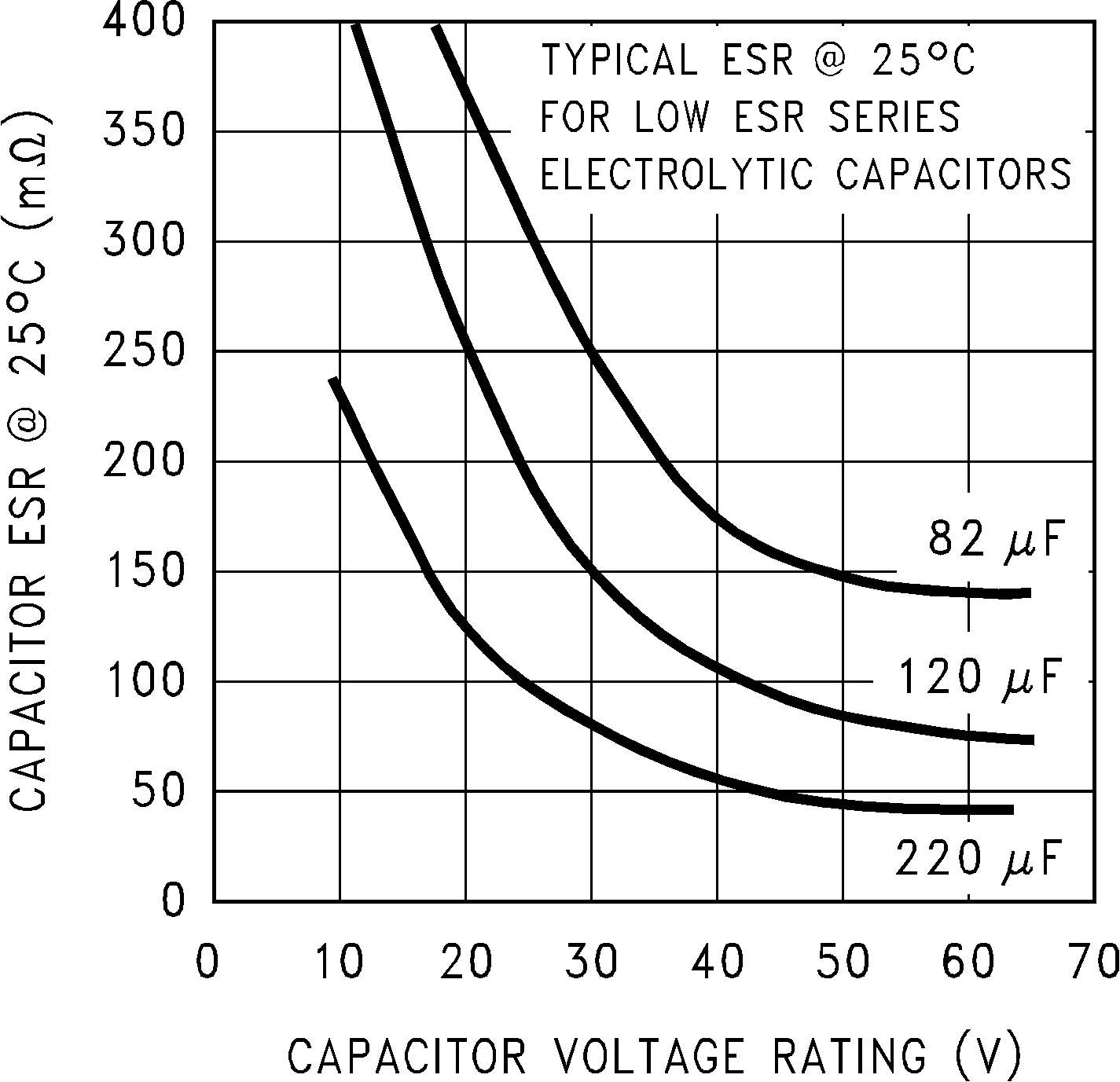SNVS118F december 1999 – may 2023 LM2594 , LM2594HV
PRODUCTION DATA
- 1
- 1 Features
- 2 Applications
- 3 Description
- 4 Revision History
- 5 Description (continued)
- 6 Pin Configuration and Functions
-
7 Specifications
- 7.1 Absolute Maximum Ratings
- 7.2 ESD Ratings
- 7.3 Recommended Operating Conditions
- 7.4 Thermal Information
- 7.5 Electrical Characteristics – 3.3 V
- 7.6 Electrical Characteristics – 5 V
- 7.7 Electrical Characteristics – 12 V
- 7.8 Electrical Characteristics – Adjustable
- 7.9 Electrical Characteristics – All Output Voltage Versions
- 7.10 Typical Characteristics
- 8 Detailed Description
- 9 Application and Implementation
- 10Device and Documentation Support
- 11Mechanical, Packaging, and Orderable Information
9.1.2 Output Capacitor (COUT)
An output capacitor is required to filter the output and provide regulator loop stability. Low impedance or low ESR Electrolytic or solid tantalum capacitors designed for switching regulator applications must be used. When selecting an output capacitor, the important capacitor parameters are; the 100-kHz Equivalent Series Resistance (ESR), the RMS ripple current rating, voltage rating, and capacitance value. For the output capacitor, the ESR value is the most important parameter.
The output capacitor requires an ESR value that has an upper and lower limit. For low output ripple voltage, a low ESR value is needed. This value is determined by the maximum allowable output ripple voltage, typically 1% to 2% of the output voltage. But if the ESR of the selected capacitor is extremely low, there is a possibility of an unstable feedback loop, resulting in an oscillation at the output. Using the capacitors listed in the tables, or similar types, provides design solutions under all conditions.
If very low output ripple voltage (less than 15 mV) is required, see Section 9.1.5 for a post-ripple filter.
An aluminum electrolytic capacitor ESR value is related to the capacitance value and its voltage rating. In most cases, Higher voltage electrolytic capacitors have lower ESR values (see Figure 9-2). Often, capacitors with much higher voltage ratings can be needed to provide the low ESR values required for low output ripple voltage.
The output capacitor for many different switcher designs often can be satisfied with only three or four different capacitor values and several different voltage ratings. See Figure 9-8 and Table 9-7 for typical capacitor values, voltage ratings, and manufacturers capacitor types.
Electrolytic capacitors are not recommended for temperatures below −25°C. The ESR rises dramatically at cold temperatures and typically rises three times at −25°C and as much as ten times at −40°C (see Figure 9-3).
Solid tantalum capacitors have a much better ESR specifications for cold temperatures and are recommended for temperatures below −25°C.
 Figure 9-2 Capacitor ESR versus Capacitor Voltage Rating (Typical Low-ESR Electrolytic Capacitor)
Figure 9-2 Capacitor ESR versus Capacitor Voltage Rating (Typical Low-ESR Electrolytic Capacitor)| OUTPUT VOLTAGE (V) | THROUGH-HOLE OUTPUT CAPACITOR | SURFACE-MOUNT OUTPUT CAPACITOR | ||||
|---|---|---|---|---|---|---|
| PANASONIC HFQ SERIES (µF/V) | NICHICON PL SERIES (µF/V) | FEEDFORWARD CAPACITOR | AVX TPS SERIES (µF/V) | SPRAGUE 595D SERIES (µF/V) | FEEDFORWARD CAPACITOR | |
| 1.2 | 220/25 | 220/25 | 0 | 220/10 | 220/10 | 0 |
| 4 | 180/25 | 180/25 | 4.7 nF | 100/10 | 120/10 | 4.7 nF |
| 6 | 82/25 | 82/25 | 4.7 nF | 100/10 | 120/10 | 4.7 nF |
| 9 | 82/25 | 82/25 | 3.3 nF | 100/16 | 100/16 | 3.3 nF |
| 12 | 82/25 | 82/25 | 2.2 nF | 100/16 | 100/16 | 2.2 nF |
| 15 | 82/25 | 82/25 | 1.5 nF | 68/20 | 100/20 | 1.5 nF |
| 24 | 82/50 | 120/50 | 1 nF | 10/35 | 15/35 | 220 pF |
| 28 | 82/50 | 120/50 | 820 pF | 10/35 | 15/35 | 220 pF |